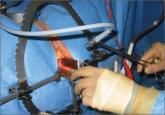From the Editor

Transfer to the hospital for women planning a home birth: A high-risk obstetrics problem
Do you have a written clinical guideline for pregnant women planning a home birth who are transferred to your hospital?

Letters from readers
Featured letters:
– Uterus ruptures at home
– A perfect candidate for home birth?
– Why women choose out-of-hospital birth
– Additional tips for vaginal hysterectomy
– Why does vaginal hysterectomy have to be so complicated?
– Suggestions to boost safety in patient positioning for MIGS
Uterus ruptures at home
A woman (G4P3) had undergone two cesarean deliveries followed by successful vaginal birth after cesarean (VBAC) in hospital. During her second trimester, the patient decided, against the advice of her ObGyn, to have a home delivery. Her midwife was present when, after several hours, the mother felt a sudden sharp pain. When the midwife detected fetal heart-rate tones of 60–70 bpm, she called 911. The patient was transported to the labor and delivery (L&D) unit where I was the in-house ObGyn on call for unattached patients.
In triage, the baby’s heart rate was in the 60-bpm range. I found no presenting part of the fetus on vaginal examination; the patient had a surgical abdomen on palpation. She was immediately taken for an emergency cesarean delivery. We found the baby halfway out of a uterine rupture. The placenta was still partially attached to the fundus.
The baby’s blood gases were too low to register on the machine. She was resuscitated, but still had no suck or gag reflex when discharged from the neonatal intensive care unit (NICU), with minimal brainstem function.
The mother didn’t require blood products because the rupture was barely bleeding. The uterine rupture occurred over the entire scar area from previous cesarean deliveries. The mother was in our hospital for a total of 14 minutes before delivery occurred.
I have no collaborative agreement with any midwife for accepting their failed home birth attempts.
Kevin Fulford, MD
San Diego, California
A perfect candidate for home birth?
In my last call as a resident, a patient arrived at L&D after arrest of labor at 5 cm for many hours. The patient was a G1P0 at term with twins and the presenting twin was in a known breech presentation. The patient quickly agreed to a cesarean delivery and has two healthy babies.
I will never forget the patient’s lay midwife telling me that the mother was the “perfect candidate for a home birth.” She seemed so disappointed by the patient’s decision to head to the hospital. It made for a memorable last night as a resident!
Erinn Hoekstra, MD
Grand Rapids, Michigan
Why women choose out-of-hospital birth
As a Board-Certified ObGyn who attends women at home, at a birthing center, and in hospital, I find this article lacking in two ways: why women choose out-of-hospital birth and why maternal outcomes at home are never discussed.
Women choose out-of-hospital birth because they are refused meaningful decision making in their labor and birth processes. They are refused VBACs, vaginal delivery of breech presentations, food and drink, and are forced to accept continuous electronic fetal monitoring (EFM), to name but a few. They also choose to stay away from the hospital because of the cascade of unscientific interventions that lead to unnecessary cesarean deliveries.
Noted in the article are neonatal outcomes, but not maternal outcomes, which are universally better outside the hospital. Fewer than 2% of women birth at home. Therefore, they can’t be responsible for the skyrocketing maternal mortality rate, the ever-increasing induction and cesarean delivery rates, and attendant accretas, etc. We have reached the point that Semmelweiss noted in Vienna in the 1800s: women who deliver outside the hospital are less likely to die than those who deliver inside.
So much hand-wringing over the few who stay away from the hospital rather than reforming the practice of obstetrics to make it safer for the majority of women who go to hospital.
Katharine Morrison, MD
The Birthing Center of Buffalo
Buffalo, New York
Dr. Barbieri responds
I appreciate the perspectives and case histories provided by Drs. Fulford, and Hoekstra. As these case reports indicate, home birth can be dangerous for both the newborn and mother. Drs. Fulford, Hoekstra, and I agree with the American College of Obstetricians and Gynecologists (ACOG) and the American Academy of Pediatrics (AAP) that pregnant women should deliver at certified birth centers or hospital-based obstetrics units in order to optimize outcomes for newborns and mothers.
Dr. Morrison supports the ACOG and AAP conclusion that women have a right to exercise their autonomy and choose a planned home birth. I know that all clinicians are deeply dedicated to continually advancing the quality of care we provide to pregnant women, regardless of their perspectives on home birth.
Additional tips for vaginal hysterectomy
I concur with Dr. Kho’s recommendations regarding vaginal hysterectomy. Having been in practice for 32 years, I have performed more than 2,000 vaginal hysterectomies and it continues to be my preferred method.
As a volunteer faculty member in the benign gynecology division of a medical school, I am dismayed at the lack of adequate training gynecologists have received upon graduation—admittedly, some because they choose something else or will perform only laparoscopic surgery.
Here are a few tips that I use to improve my success:
I developed what I call a “baby-lap” that is one-third the size of a regular laparotomy that can be used to push the bowel and other organs away to gain better visualization while removing the ovaries and performing a McCall culdoplasty.
I tell residents not to miss these vaginal hysterectomy cases instead of attending lectures, but sometimes it falls in deaf ears. I consider it my moral obligation to pass on this expertise to young gynecologists for the betterment of future generations.
Richard Nuila-Crouse, MD
Houston Texas
Why does vaginal hysterectomy have to be so complicated?
Adding more technology to a formerly straightforward procedure causes additional problems for most vaginal hysterectomies. I am a proponent of the “KISS” (Keep It Simple, Stupid) philosophy!
I don’t agree with several points that Dr. Kho presents in her article and video:
New technology has not improved the technique of performing a vaginal hysterectomy. Why make this procedure so complicated when, in reality, it is a simple, straightforward surgical procedure that can usually be performed in less than 60 minutes.
Rudi Ansbacher, MD, MS
Professor Emeritus of Obstetrics and Gynecology
University of Michigan Health System
Ann Arbor, Michigan
Dr. Kho responds
I appreciate the comments of Dr. Nuila-Crouse and Dr. Ansbacher.
The “baby-lap” that Dr. Nuila-Crouse describes sounds very similar to the vaginal packing I use, manufactured by Dukal Corporation. It is an 8-ply, 4” x 46” packing that greatly facilitates the case, particularly with the adnexectomy and placement of the sutures on the uterosacral ligaments to support the vaginal apex.
As I mentioned in the article, it is time that we update our techniques and incorporate available surgical innovation and devices to facilitate the vaginal procedure and prevent its continued decline. The use of the Magrina-Bookwalter vaginal retractor system eliminates the need for two bedside assistants. The self-retracting blades are also significantly narrower than the weighted speculum and deaver retractors traditionally used.
In addition, electro-energy has been available in laparoscopy for more than 20 years. The same principles are applied in the vaginal approach to prevent risks associated with the use of energy.
In addition to the use of the vessel-sealing device for hemostasis, I described the use of electrocautery to create a superficial relaxing incision in the mucosa of the distal posterior vagina. This incision is no more than 2–3 mm deep and does not disrupt the levator ani, much less the rectum. I have not had any complications associated with the use of this relaxing incision.

Do you have a written clinical guideline for pregnant women planning a home birth who are transferred to your hospital?

Vaginal hysterectomy is a 21st Century approach, thanks to tools, techniques, and other refinements from the fields of laparoscopy and robotics

Appropriate patient positioning for laparoscopic and robotic surgery can help prevent postoperative neuropathies. This case-based video describes...
